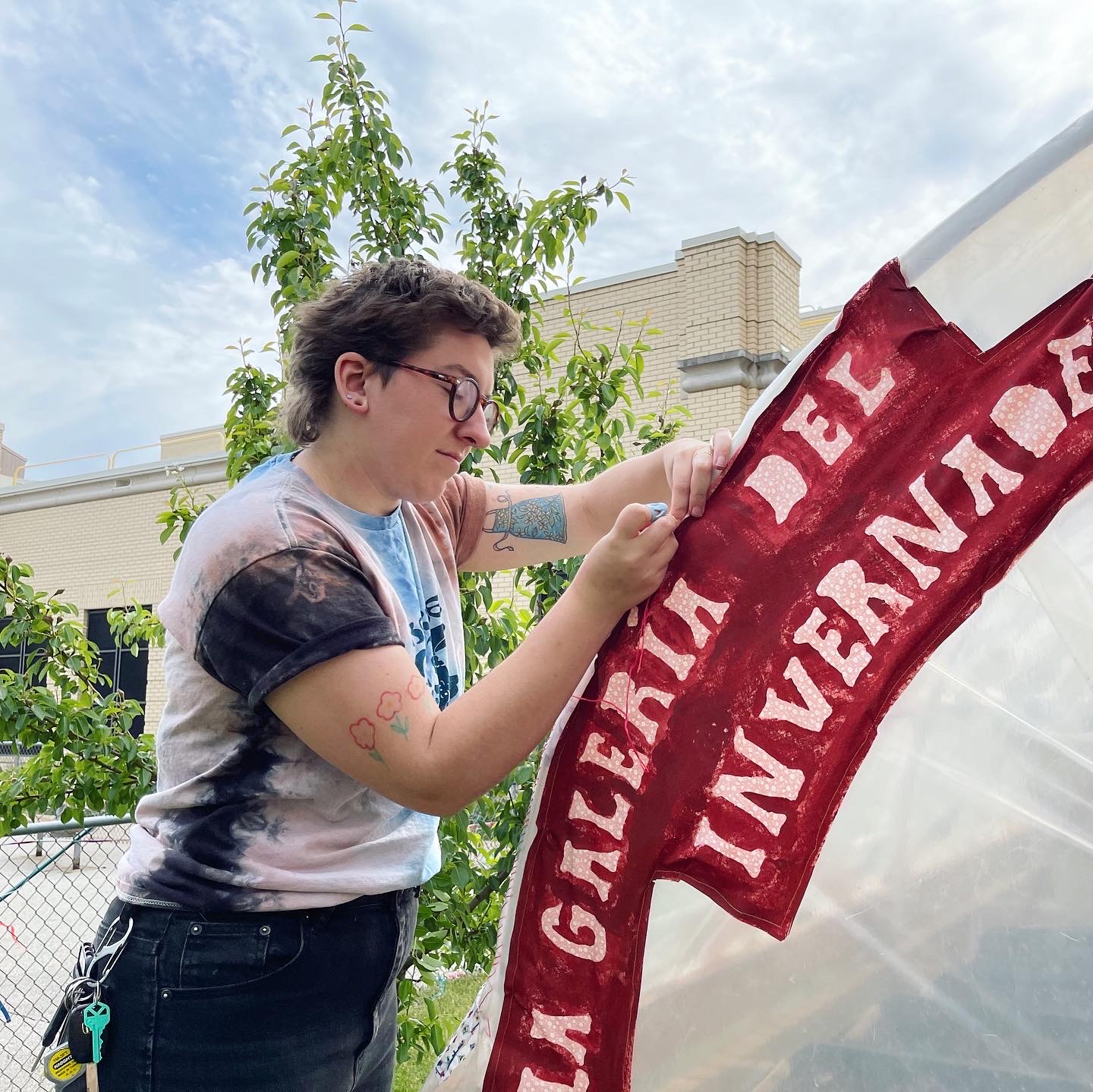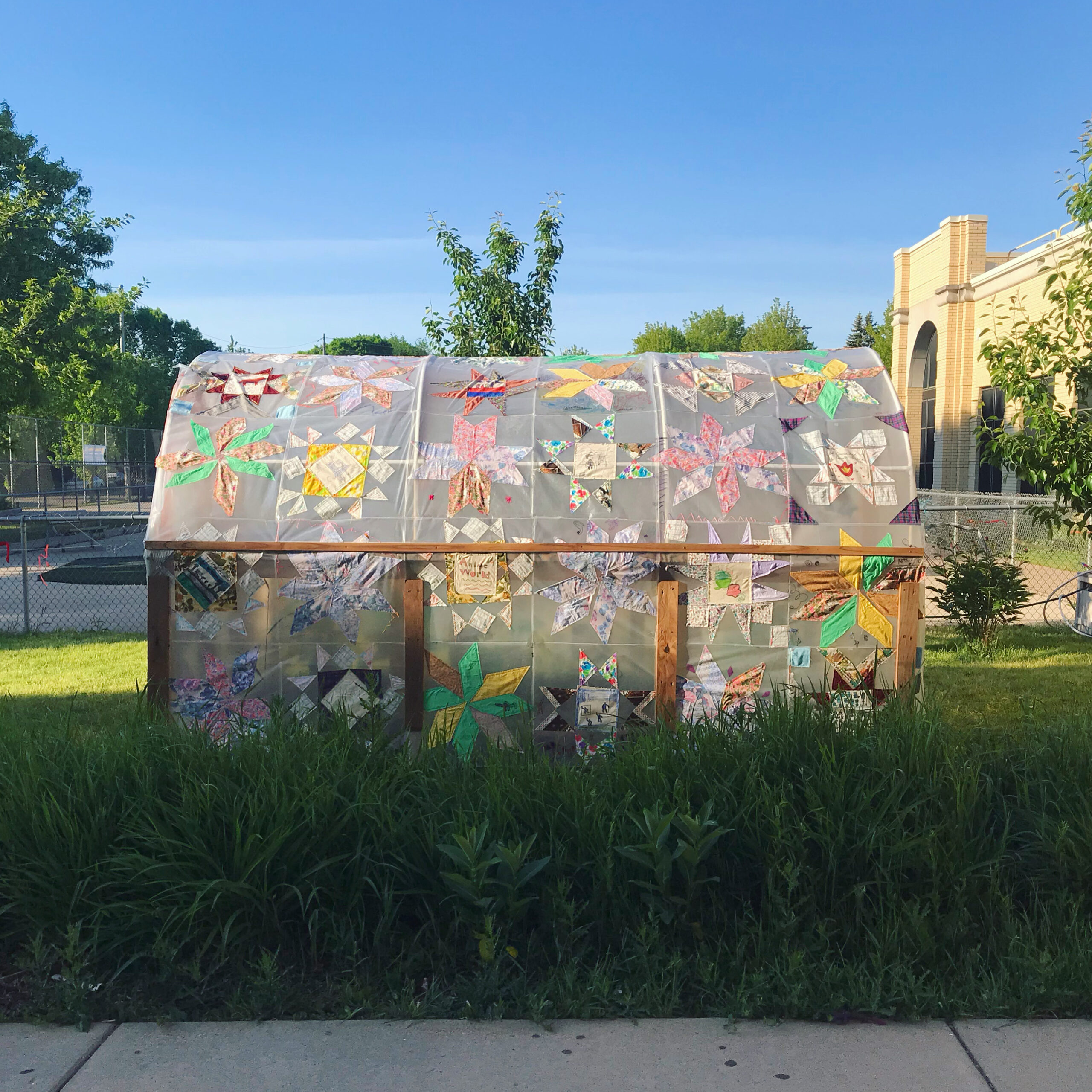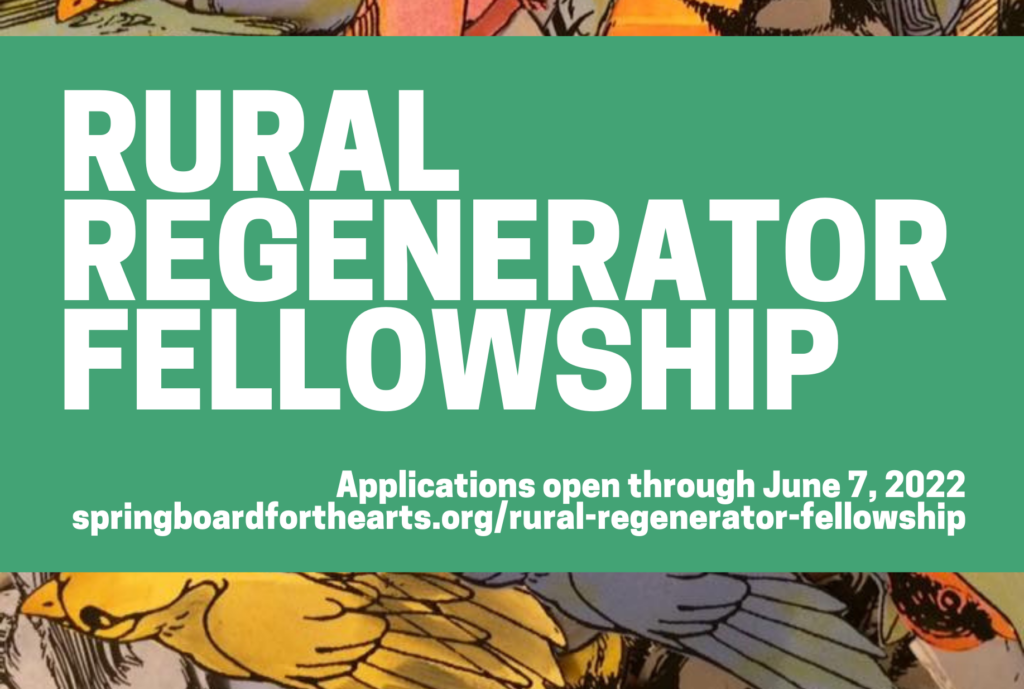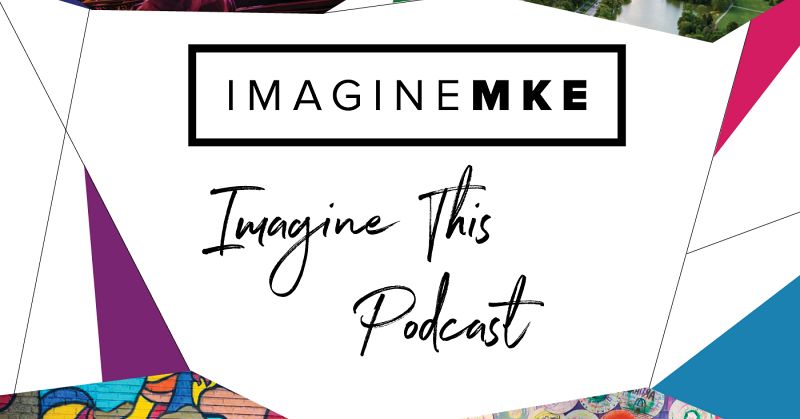Molly Hassler: Crafting Community
The Rural Regenerator Fellowship brings together individual artists, makers, and culture bearers, grassroots organizers, community development workers, public sector workers and other rural change-makers who are committed to advancing the role of art, culture and creativity in rural development and community building. In 2022, we asked a collective of local writers to sit down with current Rural Regenerator cohort members to share more about their work.
“Art just seems to be the way that I communicate best with people” Molly Hassler shares as they walk me through their newest project they’ll continue with the support of the Rural Regenerator Fellowship—“she was a public house.” Trans cherub angel persons adorn a fabric banner in their studio which also serves as the current ongoing site of an installation and social practice project. Hassler leads me through the drawing of the bar cart prototype they’ll begin constructing to create an interactive bar service that they hope can travel beyond the studio site as they search for a more permanent place to install the project. Their practice involves drawing, zine and printmaking, and fiber arts trending toward sewing, pieceworking, machine embroidering and quilting. Hassler brings these artistic approaches together for their 3D installation possibilities embodying what they refer to as a folk aesthetic. This folk aesthetic is drawn from a commitment to exploring themes of home “in all its complexity.”
 Home for Hassler these days means traveling the roughly one hour drive from Milwaukee to Watertown, Wisconsin. Having grown up in Watertown, “she was a public house” commemorates the working people of a local tavern, and the feelings Hassler has about the dive bar where their mom worked for the first 25 years of Hassler’s life. The work is currently installed and continually shifting in their studio space in Milwaukee. Doing work in both places means much of Hassler’s art focuses on bringing together the disparate worlds of which they are a part.
Home for Hassler these days means traveling the roughly one hour drive from Milwaukee to Watertown, Wisconsin. Having grown up in Watertown, “she was a public house” commemorates the working people of a local tavern, and the feelings Hassler has about the dive bar where their mom worked for the first 25 years of Hassler’s life. The work is currently installed and continually shifting in their studio space in Milwaukee. Doing work in both places means much of Hassler’s art focuses on bringing together the disparate worlds of which they are a part.
As a member of a small town working class community and the queer community, Hassler navigates these geographies advocating that they are more similar than different. They see both communities as rooted by the ethics of chosen family, noting that in their experience growing up in Watertown was one where they articulate, “when many people care for you, it’s like the whole community cares for you.”
Hassler is certain their queerness is homegrown, meaning it emerges from this small, rural town setting and isn’t defined by the metronormativity narratives often presented as the only possibility for queer people’s existence. “she was a public house” is a visual representation of an important working-class space through the lens of a queer artist. Hassler’s work then, in drawing attention to bar and tavern spaces of Watertown and Milwaukee allows them to weave together the experiences of these communities through their interpretations of family, home, and community in fabric banners, distillery mirrors, framed drawings, and artistically reproduced tools that shape the functions and feelings of these gathering spaces.
Hassler argues that another way that queer communities and rural communities are more similar than not is the way that both communities engage in creative problem-solving. Through recognizing these similarities, Hassler is compelled to find ways to try to bring these communities more in contact with each other. Hassler’s focus on home across these two communities emerges from a deep love and care for rural and queer spaces. And they are eager to find opportunities for collaborating with other Rural Regenerator Fellows who engage social practice in their artistic works as well. At this point in their artistic career they are entering into a phase of asking a lot of people for help to realize their visions. They’ll be using their time as a Rural Regenerator Fellow this year to collaborate with people who have skills that they don’t, drawing on resources in Milwaukee to help with ceramics and woodworking for the next phase of “she was a public house.” They are excited to engage with folks in the cohort with theater backgrounds to think through how some of their skills might translate into the interactive social practice bartending element of their installation work.
These exciting ideas shaping Hassler’s work ahead are in line with how they understand rural regeneration. To Hassler, rural already has what it needs to survive. They see their job as an artist as not only coming up with unique ideas but more as facilitator, to draw out what community may already have to enhance the community’s capacity to care for itself. Hassler advances that rural regeneration today is about finding more opportunities to facilitate skill-sharing and drawing on the inherent neighborliness found in rural communities.
Sharing skills is an important part of Hassler’s artistic practice. “I would just love to be doing workshops all over Wisconsin, sewing workshops, how to make your own clothes.” Bringing together community, skill-sharing and fiber-based artistic practices that benefit the rural queer community of which they are a part, is the perfect melding of Hassler’s interests and desire to share their knowledge. In lieu of workshops, Hassler created a downloadable worksheet/comic available on their website “i keep my feelings in my chest.” The worksheet/comic details Hassler’s process in devising the instructions for a binding garment and provides the instructions for interested folks to make their own.
Hassler’s project not only fills an important need for folks who bind, they also provide the information in language that aims to not induce gender dysphoria. Hassler is driven to share their skills with others, and motivated by their personal aesthetic philosophies. On reflecting on their options for clothing, Hassler states, “a lot of clothing for transmasculine folks is neutral, and baggy, and not colorful, which is totally fine, but I want to wear something fabulous.” This trend toward the fabulous means colorful options, clothes that understand Hassler’s gender as “trans non-binary as both/neither…or beyond.” In the mainstream shopping experience Hassler has been frustrated with the options that trend toward “neither” and “neutral.” Their sentiments in the comics/worksheet clearly state their position on the matter, “I don’t live in a neutral body” Hassler writes, “I live in a trans body that deserves personalized garments. All trans people do.”
Hassler’s mixed media installation works, fabric works, and educational offerings mirror the attention on the specificity of a fabulousness found within their work. This educational aspect of Hassler’s work shines through in the ways they bring together their expertise as someone who studied fibers arts and community studies. In school, they were trained to keep these areas separate, but like their mixed media practice, Hassler found their growth as an artist came faster and had broader impact when they worked with other people. They enjoy infusing community interaction alongside the fibers creations. Perhaps this is one reason why they are so drawn to social practice work where the community is helping shape the meaning of the work alongside the artist. “Artists and writers and workers can see a community’s capacity and cultivate it” Hassler reminds me, as they describe how their practice continues to engage these efforts. Like the rural communities Hassler describes with their work, the art installations and social practice engagements are adaptive, shifting and changing to meet the context and environment in meaningful ways.
 Their collaborative work has shaped their practice and helped them make meaning of their purpose as an artist. Some previous experiences such as working as an artist in residence at a retirement home for two years and as a teaching artist with youth over the last four years has helped them see how creativity can be cultivated in others. Hassler is particularly proud in uplifting those who may not see themselves as artists. This principle guides Hassler’s collaborative spirit. As a current teaching artist in residence with Lynden Sculpture Garden in Milwaukee, Hassler credits the quarterly education institute talks as an important way they’ve come to frame their work via cultivation and through the language of “worlding.” Hassler explains that worlding “is not necessarily imaging a utopia, but instead it’s about the art of making do with what we have.”
Their collaborative work has shaped their practice and helped them make meaning of their purpose as an artist. Some previous experiences such as working as an artist in residence at a retirement home for two years and as a teaching artist with youth over the last four years has helped them see how creativity can be cultivated in others. Hassler is particularly proud in uplifting those who may not see themselves as artists. This principle guides Hassler’s collaborative spirit. As a current teaching artist in residence with Lynden Sculpture Garden in Milwaukee, Hassler credits the quarterly education institute talks as an important way they’ve come to frame their work via cultivation and through the language of “worlding.” Hassler explains that worlding “is not necessarily imaging a utopia, but instead it’s about the art of making do with what we have.”
This frame has encouraged Hassler to think deeply about platonic intimacies and how this has influenced their homegrown Wisconsin queer identity. These themes thread through their work and ripple outward influencing those who come in contact with it and then also reach back to the work itself thus changing it. Ultimately worlding enables Hassler to represent queer world-making in rural space. This is an important counterpoint to the assumption that queer and trans people don’t live and thrive in rural spaces.
Hassler’s work is filled with love, joy, humor, charm, and liveliness. Their work and community engagement corrects the erasure of representations of queer life in rural Midwestern spaces. Whether they’re thinking through how to serve a large batch beverage on a homemade bar cart or creating interactive collaborative world building opportunities like playing darts together, Hassler centers community as necessary to the creation and life of their art. With kindness and generosity Hassler inspires us all to recognize the gifts of working-class and queer community members in our rural places.





